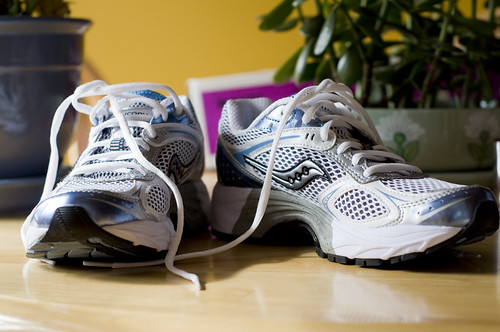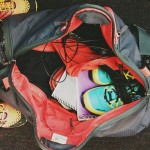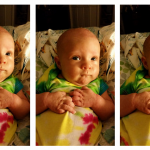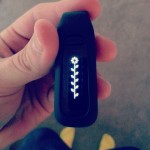
I am admittedly a newbie runner. If you had asked me even a year ago what shoes were best for running, I would have pointed to anything that wasn’t a pump or sandal. I believed that whatever enabled you to run without feeling the rocks or broken glass got the green light. I stand very corrected.
Neil surprised me early for Valentine’s Day this past weekend by taking me for a professional shoe fitting that ended with these lovely Saucony ProGrid Guide 2’s. They are like running on pillowy puffs of air. After endeavoring to run a 10k by the end of 2010 and starting the very basic training programs and techniques, I quickly learned that my Nike Shox were not optimum for running. As I’m a complete newb, this process was really informative. I learned a lot about not only my particular feet and stride, but how stride works, and how shoes are designed to optimize and improve for the best run possible.
What Did I learn?
Even if you aren’t feeling pain, your feet are uniquely designed and therefore create a stride and step that is all your own. When you run normally (or walk):
- 1. The outside of the heel strikes the ground first. This is called a supinated position.
- 2. The foot then rolls inward and flattens out along the lengthwise arch-pronation. This is called pronation.
- 3. The foot then supinates by rolling through the ball.
Usually, when (yes it’s a matter of when apparently) you develop an injury it’s because you either supinate (roll out) or pronate (roll in) too much. Normal amounts of pronation and supination are needed for normal function, but abnormal amounts increase the risk for injury. The excessive amount of either will determine if you need a neutral running shoe with an even amount of motion control and mild shock absorption, or a shoe designed for mild, moderate, or severe amounts of pronation/supination with mild, moderate, or severe control.
After standing, squatting, running on a treadmill barefoot and getting my feet thoroughly groped, the specialists determined that I’m rather normal (boring huh?) with a slight pronation inequality favoring my right foot. I tried on at least twenty pairs of shoes and because of my narrow heels and skinny feet found it really hard to find a shoe that didn’t feel like a loose sock. In trying on all these shoes and talking the ear off the specialists, I’ve come up with what I feel is a great list of tips for shopping for the perfect running shoes.
Things to Remember When Shopping for a Running Shoe
- 1. Do not buy shoes unless you’ve had your feet fitted and assessed. I’ve learned my lesson and will never buy and off-the-rack department store shoe.
- 2. Wear socks that you would typically wear running.
- 3. Bring 1 or 2 pairs of your current running shoes. A person trained in fitting running shoes can better assess where your shoes tend to wear most heavily.
- 4. Know your stats to determine what your usage will be. Know how many miles you run per week and what injuries you’ve sustained in the past.
- 5. Be sure to run in them, not just 5 minutes, but maybe a full mile.
- 6. Try several brands and models to get a full spectrum of different fits.
- 7. Get both feet measured individually. It is not uncommon to have two
different-sized feet. - 8. Make sure the shoe easily flexes where the foot flexes.
- 9. If you use orthotics, get the shoes fitted with them installed.
- 10. Don’t rely on a break-in period. Running shoes should feel good the day you buy them.
So there are my newbie shopping tips. I may be a newb, but I fully advocate and encourage getting your feet sized and fitted to a running shoe. By all indications of those more informed and experienced than me, it probably won’t prevent injury (that seems inevitable) but greatly enhance the enjoyment of the experience and at least give you some better odds.
So how am I doing at goal of running a 10k by the end of the year? I’m currently training for my first 5k and up to the 2 mile marker. I’m hoping to run my first 5k (unfortunately on the deathmill) this weekend. I’m taking it slow to build the mucles and muscle memory in my legs to avoid unnecessary injury where I can. It’s exciting, and I really appreciate all the encouragement and tips I’ve received from amazing friends, both online and not.
You may also like







You know you could just suck it up and run the 5k race around Stephan’s Lake park at 11 on Saturday with me. No treadmill required. Details here: http://bit.ly/8YoVq2
Great post. And good tips. PS: You should get new shoes every 300-500 miles. That’s a large range, but here’s a good way to think of it: A runner who runs approximately four days per week and runs approximately three to five miles each time will need new shoes every 6 months or so. Someone with higher mileage (training for half and full marathons) will need to get new shoes more often. I was finding when I trained for the marathon, I needed new shoes every three months.
I love this post. Very good information! I’m a pronation girl, and I’ve found the best match for my little issues. I agree about bringing your old running shoes when shopping. It really helps to find the closest fit! Good luck on your training!
Thanks guys!
I very much agree Ashley, you have to replace them often and that was the first thing they impressed upon me when I told them I’d had my Shox for two years. I’m guessing at this point I’ll be an every 6 months purchaser, but that could very easily change.